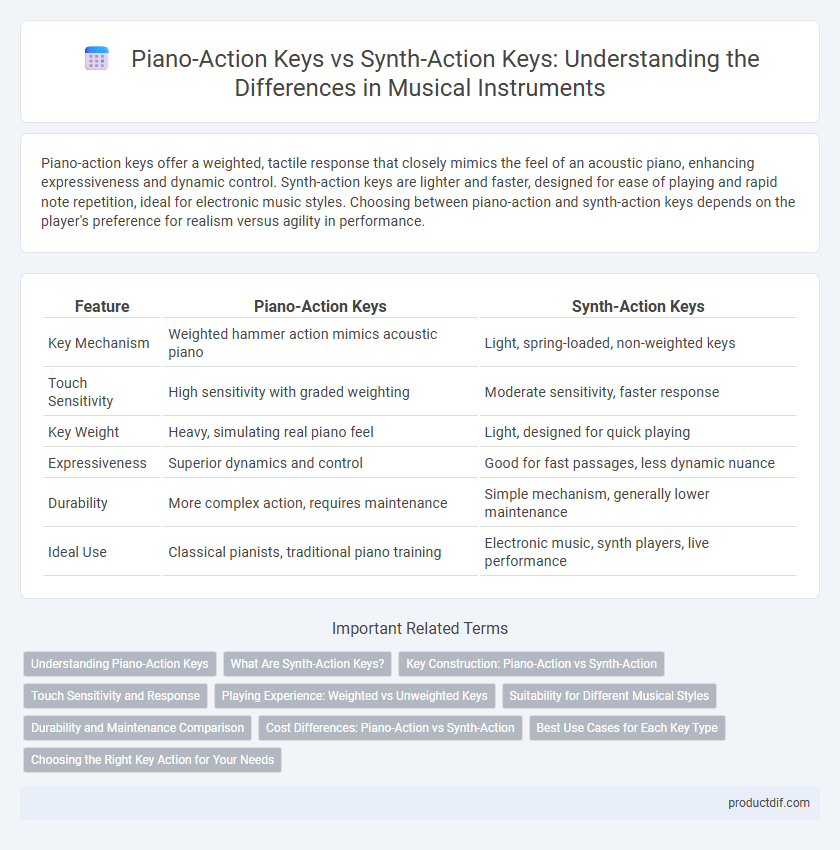Piano-action keys offer a weighted, tactile response that closely mimics the feel of an acoustic piano, enhancing expressiveness and dynamic control. Synth-action keys are lighter and faster, designed for ease of playing and rapid note repetition, ideal for electronic music styles. Choosing between piano-action and synth-action keys depends on the player's preference for realism versus agility in performance.
Table of Comparison
| Feature | Piano-Action Keys | Synth-Action Keys |
|---|---|---|
| Key Mechanism | Weighted hammer action mimics acoustic piano | Light, spring-loaded, non-weighted keys |
| Touch Sensitivity | High sensitivity with graded weighting | Moderate sensitivity, faster response |
| Key Weight | Heavy, simulating real piano feel | Light, designed for quick playing |
| Expressiveness | Superior dynamics and control | Good for fast passages, less dynamic nuance |
| Durability | More complex action, requires maintenance | Simple mechanism, generally lower maintenance |
| Ideal Use | Classical pianists, traditional piano training | Electronic music, synth players, live performance |
Understanding Piano-Action Keys
Piano-action keys replicate the precise mechanical movement of an acoustic piano, delivering authentic resistance and tactile feedback crucial for expressive playing. These keys use weighted hammers and complex lever systems that simulate the touch sensitivity and dynamic control found in traditional pianos. Understanding piano-action keys is essential for musicians seeking realistic performance and nuanced control, especially in classical and jazz genres.
What Are Synth-Action Keys?
Synth-action keys mimic the light, spring-loaded feel of synthesizers, providing a faster, more responsive touch ideal for electronic music styles. Unlike piano-action keys that use weighted hammers to simulate acoustic piano mechanics, synth-action keys rely on a simple, non-weighted mechanism allowing for quicker key repetition and greater dynamic control. These keys are often preferred by performers seeking agility and expression in genres such as pop, rock, and electronic music.
Key Construction: Piano-Action vs Synth-Action
Piano-action keys feature a complex mechanical system with weighted hammers and escapement mechanisms designed to replicate the touch and responsiveness of an acoustic piano. Synth-action keys use lighter, spring-loaded mechanisms that prioritize speed and ease of playing but lack the nuanced resistance found in piano actions. The key construction in piano-action emphasizes durability and expressive control, while synth-action keys focus on affordability and portability for electronic instruments.
Touch Sensitivity and Response
Piano-action keys feature weighted hammer mechanisms that replicate the nuanced touch sensitivity and dynamic response of an acoustic piano, enabling expressive control over volume and tone. Synth-action keys, often lighter and spring-loaded, prioritize rapid responsiveness and ease of play but typically lack the gradual resistance and nuanced feedback characteristic of piano-action keys. Musicians seeking authentic touch dynamics value piano-action keys for their ability to deliver varied articulation, while synth-action keys appeal to those prioritizing speed and versatility in sound design.
Playing Experience: Weighted vs Unweighted Keys
Weighted piano-action keys offer a tactile resistance similar to an acoustic piano, enhancing finger strength and dynamic control essential for expressive performances. In contrast, synth-action keys are typically unweighted, providing a lighter, more springy feel that allows for faster repetition and easier playability but less nuanced touch sensitivity. Musicians seeking authentic classical technique and gradual touch response often prefer weighted keys, while those focused on electronic music or rapid key sequences may favor the responsiveness of unweighted synth-action keys.
Suitability for Different Musical Styles
Piano-action keys offer a weighted and responsive touch ideal for classical, jazz, and expressive solo performances that demand dynamic control and nuanced articulation. Synth-action keys feature lighter, faster key responses suitable for electronic, pop, and contemporary music styles where rapid note changes and extended playability support complex sound layering and modulation. Choosing between piano-action and synth-action keys depends on the musical genre and performance needs, balancing tactile feel with stylistic versatility.
Durability and Maintenance Comparison
Piano-action keys feature a complex mechanical mechanism with hammers and weighted keys, providing exceptional durability but requiring regular maintenance such as regulation and voicing to maintain optimal performance. Synth-action keys utilize electronic sensors and lighter plastic keys, offering greater resistance to wear and virtually maintenance-free operation, though they lack the tactile feedback of traditional piano keys. The choice between the two depends on the desired balance between authentic touch and hassle-free upkeep.
Cost Differences: Piano-Action vs Synth-Action
Piano-action keys, often made with weighted hammers and intricate mechanical components, generally incur higher manufacturing and maintenance costs compared to synth-action keys, which utilize lighter, spring-based mechanisms or sensors. These cost differences reflect in retail prices, with acoustic pianos and high-end digital pianos featuring piano-action keys typically priced significantly above synthesizers or digital keyboards equipped with synth-action keys. The investment in piano-action keys is justified by superior tactile response and authentic playing feel preferred by classical pianists and serious musicians.
Best Use Cases for Each Key Type
Piano-action keys excel in replicating the tactile response and weighted feel of an acoustic piano, making them ideal for classical pianists and advanced players seeking expressive control and nuanced dynamics. Synth-action keys, being lighter and more responsive, are best suited for genres requiring rapid note repetition and extensive modulation, such as electronic, pop, and jazz music. Choosing between these key types depends on the player's style, with piano-action favoring traditional technique and synth-action enhancing versatility and speed.
Choosing the Right Key Action for Your Needs
Piano-action keys replicate the weighted, hammer-like mechanism of an acoustic piano, providing a responsive touch and dynamic control essential for classical and expressive playing styles. Synth-action keys are lighter and faster, designed for electronic synthesizers, allowing rapid note repetition and ease in playing complex rhythms or fast passages. Choosing the right key action depends on your musical genre, playing technique, and whether you prioritize authentic piano feel or versatility for electronic music production.
Piano-action keys vs Synth-action keys Infographic

 productdif.com
productdif.com